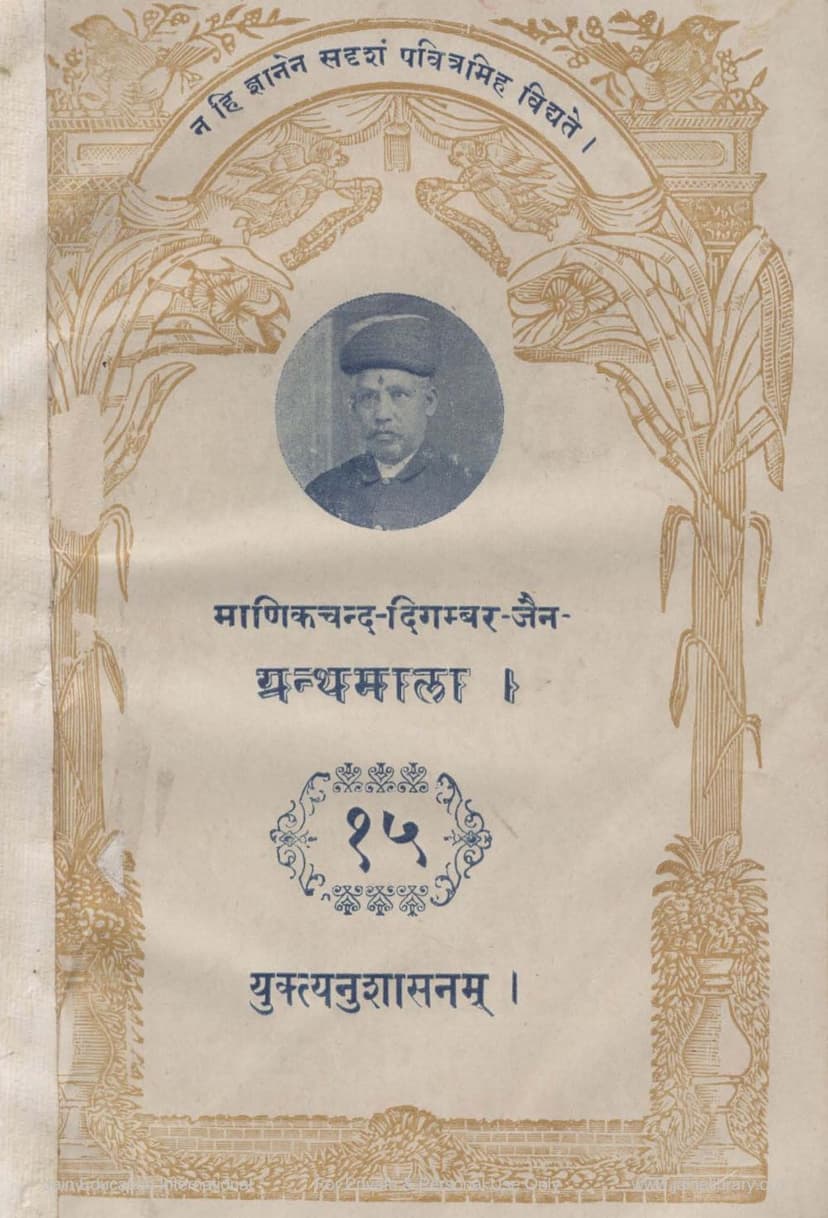Yuktyanushasanam
Added to library: September 2, 2025

Summary
Here's a comprehensive summary of the Jain text "Yuktyanushasanam" based on the provided pages:
Title: Yuktyanushasanam (युक्त्यनुशासनम्)
Author: Acharya Samantabhadra (प्रणीतं युक्त्यनुशासनम्) Commentary (Tika): Acharya Vidyanandacharya (श्रीविद्यानन्दाचार्यविरचितया टीकया समन्वितं) Editors: Pandit Indralal Pandit and Pandit Shreelal Pandit (साहित्यशाखि-पण्डितइन्द्रलालैः काव्यतीर्थ-पण्डित श्रीलालैश्च सम्पादितं संशोधितं च) Publisher: Manikchand Digambar Jain Granthamala Samiti (प्रकाशयित्री माणिकचन्द्र-दिगम्बर-जैन-प्रन्थमाला-समितिः) Publication Date: Vaishakh, Vir Nirvana Samvat 2446 (वैशाख, श्रीवोर नि० संवत् २४४६), First Edition: V.S. 1977 (वि० सं० १९७७)
Overview:
Yuktyanushasanam is a significant Jain philosophical text, which is a commentary on a hymn or prayer authored by the revered Acharya Samantabhadra. The text is presented with a detailed commentary by Acharya Vidyanandacharya, a prominent Jain philosopher and logician. The publication itself is a testament to the efforts of the Manikchand Digambar Jain Granthamala Samiti.
Key Aspects and Content:
-
Purpose and Nature: The title Yuktyanushasanam suggests a "governance or discipline of logic" or "guidance through reasoning." The text likely aims to establish the principles of Jain philosophy and logic through rigorous argumentation and discourse, as evidenced by the extensive commentary on the fundamental tenets.
-
Commentary by Vidyanandacharya: Acharya Vidyanandacharya, also known as Patrakesari, is a highly esteemed Jain scholar known for his mastery of logic and philosophy. His commentary is crucial for understanding the original hymn's depth. The commentary delves into profound philosophical debates, engaging with concepts from both Jain and other Indian philosophical schools.
-
Scholarly Context: The introductory pages highlight the historical and philosophical context of Acharya Vidyanandacharya.
- Possible Origins: While one story places him in Magadha, his life was likely spent primarily in South India and Karnataka, a region known for its flourishing Jain philosophical traditions and the presence of other great scholars like Akalanka.
- Chronological Placement: The text places Vidyanandacharya after Bhartrihari and in roughly the same period or slightly later than Kumaril Bhatta and Mandana Mishra, renowned scholars from other philosophical traditions. His work is seen as a refutation of their arguments and a defense of Jainism.
- Influence: Vidyanandacharya is mentioned as an influential figure, with later scholars referencing his works. The dating of his works is crucial for understanding the evolution of Jain logic.
- List of Works: The text mentions several other works attributed to Vidyanandacharya, including Ashtasahasri, Shlokavartikalankara, Aptapariksha, Patrapariksha, Pramanapariksha, Patrakesaristotra, and the commentary on Yuktyanushasana.
-
Philosophical Discourse (from the commentary): The extensive commentary (starting from page 16) engages in detailed debates on various philosophical points. Some of the recurring themes and arguments touched upon include:
- Nature of Knowledge (Pramana): The text discusses the nature of valid knowledge, distinguishing between sensory perception (Pratyaksha) and inference (Anumana). It critically examines different theories of knowledge, particularly in relation to conceptualization and reality.
- Realism vs. Idealism: There's a clear engagement with the Buddhist doctrine of momentariness (Kshanika) and subjective idealism (Vijnyana-matra), challenging their core tenets of emptiness and the absence of inherent reality.
- Ananta-dharma (Infinite Attributes): The Jain concept of Anekanta-vada (non-absolutism or manifoldness of reality) is implicitly defended by refuting single-sided views.
- Samsara and Moksha: The text discusses the causal mechanisms of the cycle of birth and death (Samsara) and the path to liberation (Moksha), often in contrast to other philosophical viewpoints.
- Language and Meaning: The role of language, concepts, and their relation to reality is explored, particularly the inadequacy of exclusive linguistic formulations.
- Critique of Other Schools: Significant portions of the commentary are dedicated to critiquing the philosophical positions of other schools, such as Buddhism (momentariness, subjective idealism), Mimamsa (eternal Vedic authority), Vaisheshika, and Sankhya, highlighting their internal contradictions and incompatibility with reality as understood by Jainism.
- The Role of Syat-vada: The Jain doctrine of conditional predication (Syat-vada) is likely presented as the logical framework to reconcile seemingly contradictory aspects of reality.
-
Praise for Acharya Samantabhadra: The hymn itself, as indicated by the commentary, is a form of praise for Acharya Samantabhadra, likely highlighting his wisdom, logical prowess, and contributions to Jain philosophy.
-
Editorial and Publication Effort: The publisher's note on page 4 acknowledges a financial contribution, indicating the effort and resources involved in bringing this ancient text to light. The editors' meticulous work in compiling and revising the text is also mentioned.
In Essence:
Yuktyanushasanam is a profound philosophical work that, through the commentary of Acharya Vidyanandacharya, dissects and defends the core tenets of Jain epistemology and ontology. It engages in rigorous logical debate, refuting alternative philosophical viewpoints and establishing the Jain perspective on reality, knowledge, and liberation. The text serves as a vital resource for understanding the sophisticated philosophical reasoning developed within the Jain tradition.